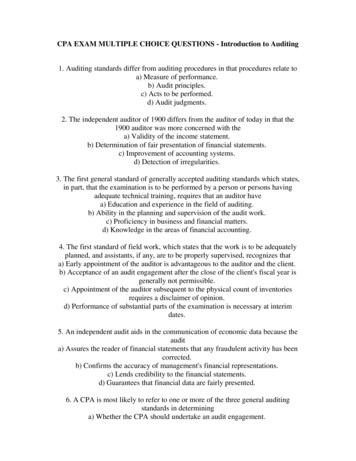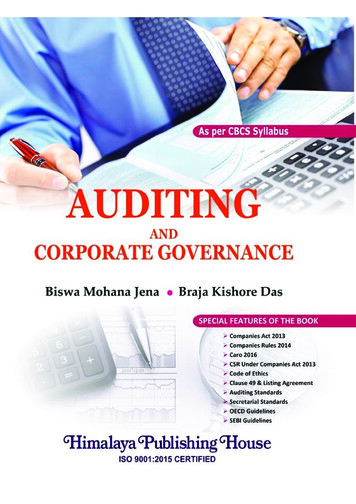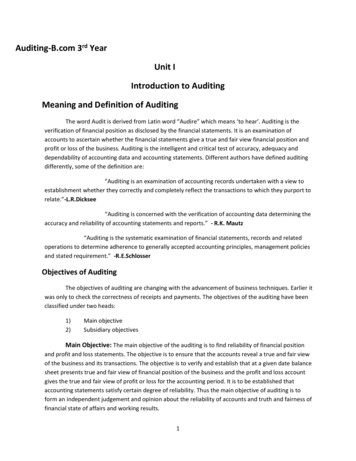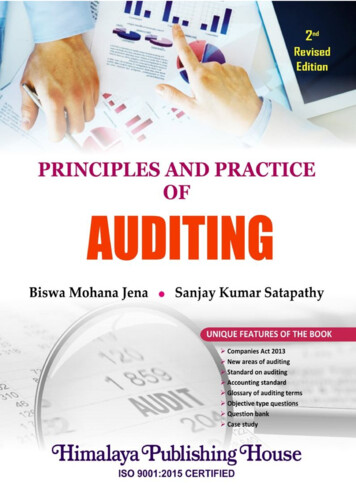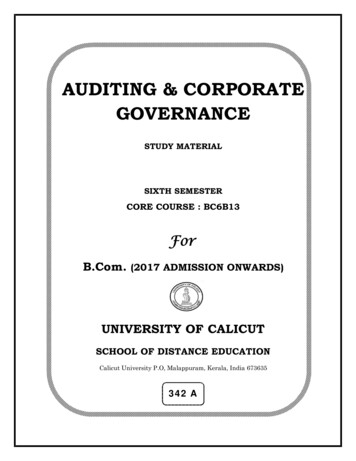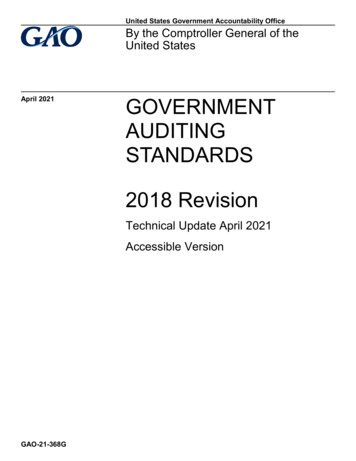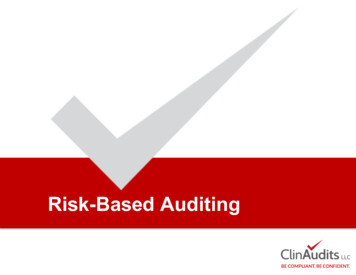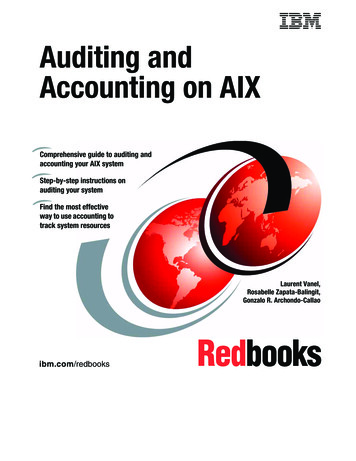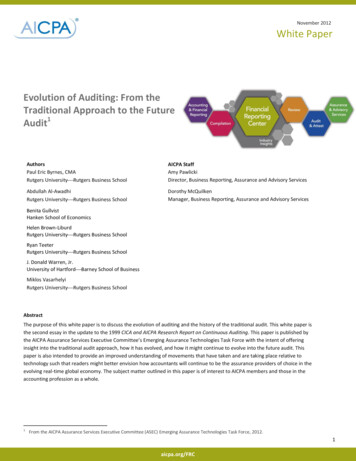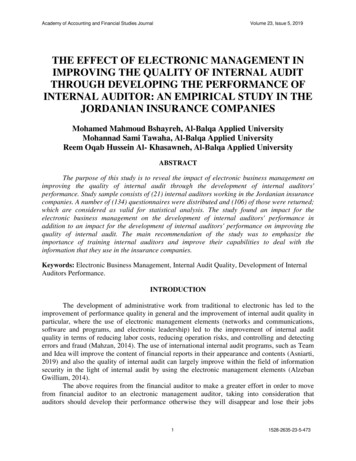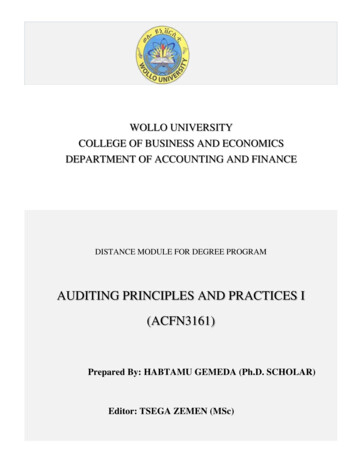
Transcription
WOLLO UNIVERSITYCOLLEGE OF BUSINESS AND ECONOMICSDEPARTMENT OF ACCOUNTING AND FINANCEDISTANCE MODULE FOR DEGREE PROGRAMAUDITING PRINCIPLES AND PRACTICES I(ACFN3161)Prepared By: HABTAMU GEMEDA (Ph.D. SCHOLAR)Editor: TSEGA ZEMEN (MSc)1
WOLLO UNIVERSITYCOLLAGE OF BUSINESS AND ECONOMICSDEPARTMENT OF ACCOUNTING AND FINANCEDISTANCE MODULE FOR DEGREE PROGRAMAUDITING PRINCIPLES AND PRACTICES I(ACFN3161)Prepared by: HABTAMU GEMEDA (Ph.D. Scholar)Editor: TSEGA ZEMEN (Assi.Professor)Distance Education Program20202
Table of ContentsContentsTable of Contents . 3Preface. 4About the Course . 5Chapter 1: An Overview of Auditing. 8Chapter 2: The Auditing Profession . 23Chapter 3: Planning and Conducting the Audit . 42Chapter 4: Internal Control . 56Chapter 5: Audit Evidence . 71Chapter 6: Audit Reports . 83Chapter 7: Auditing and Auditors in Ethiopia . 94Answer Key . 104References . 1083
PrefaceDear Students!Why this Course? Economic decisions in every society must be based upon the informationavailable at the time the decision is made. For example, the decision of a bank to make a loan toa business is based upon previous financial relationships with that business, the financialcondition of the company as reflected by its financial statements and other factors. If decisionsare to be consistent with the intention of the decision makers, the information used in thedecision process must be reliable. Unreliable information can cause inefficient use of resourcesto the detriment of the society and to the decision makers themselves. In the lending decisionexample, assume that the barfly makes the loan on the basis of misleading financial statementsand the borrower Company is ultimately unable to repay. As a result the bank has lost both theprincipal and the interest. In addition, another company that could have used the fundseffectively was deprived of the money.As a means of overcoming the problem of unreliable information, the decision-maker mustdevelop a method of assuring him that the information is sufficiently reliable for these decisions.In doing this he must weigh the cost of obtaining more reliable information against the expectedbenefits. A common way to obtain such reliable information is to have some type of verification(audit) performed by independent persons. The audited information is then used in the decisionmaking process on the assumption that it is reasonably complete, accurate and unbiased.To help students to clear understand the fundamental principles and practices of auditing,auditing principles and practices I explores the underlying theories, procedures and practicessurrounding the auditor's responsibilities in undertaking an audit. It deals with the auditingprofession, the process of collecting and evaluating evidence to determine whether an economicentity safeguards assets, maintains data integrity, and produces reliable financial statements. Italso covers the study and evaluation of internal control and the role of internal auditors in fraudprevention and detection. Audit reports on financial statements and the most frequent variationsin audit are also covered. In the next course auditing principles and practices II, you will studyapplication of auditing theories, procedures and practices to specific items of balance sheet andincome statement items.4
About the CourseCollege of Business and EconomicsDepartment of Accounting and FinanceCourse InformationCourse Number: AcFn 3161Course Title: Auditing Principles and Practices IETCTS Credits: 5 HoursContact Hours (per week): 3 HoursCourse Objectives & Competences to be AcquiredAt the end of the course students will be able to: Understand the nature, types, and utility [to the society] of Auditing. Be acquainted with the underlying professional standards that Public Accountingemploys and the primary legal concepts and terms therein. Comprehend the significance of internal control assessment in the planning andconducting of an audit. Distinguish the different types of Audit Reports and the variety of circumstances andconditions where one is more appropriate than the others. Be familiar with the working of the auditing profession in Ethiopia.Course DescriptionThis course explores the underlying theories, procedures and practices surrounding theauditor's responsibilities in undertaking an audit of financial statements of reporting entities. Itdeals with the auditing profession, the process of collecting and evaluating evidence todetermine whether an economic entity safeguards assets, maintains data integrity, andproduces reliable financial statements. It also covers the study and evaluation of internalcontrol and the role of internal auditors in fraud prevention and detection. Audit reports on5
financial statements and the most frequent variations in audit are also covered.Course Contents1.An overview of auditing1.1 Definition and Nature of Auditing1.2 Accounting vs. auditing1.3 Type of Audit and AuditorsEconomics of Auditing2.The auditing profession2.1.Generally accepted auditing standards2.1.1. General standards2.1.2. Standards of Filed work2.1.3. Standards of Reporting2.2.Professional Ethics2.3.Legal responsibility and Liability3. Planning and conducting the Audit3.1.Reasons for Audit planning3.2.Planning procedures3.3.Designing of Audit program3.4.Audit working paper3.5.Audit risk3.6.Materiality4. Internal Control4.1.Meaning of Internal Control4.2.Internal Control and Internal Audit4.3.Control Environment4.4.Risk Assessment4.5.Control Activities4.6.Limitation of Internal Control4.7.The Auditor's Consideration of internal control5. Audit Evidence6
5.1. The relationship of evidence to audit risk5.2. Financial statement assertions5.3. Sufficient competent evidential matter5.4. Types of audit evidence5.5. Evidence about accounting estimates6. Audit Reports6.1. Types of audit reports6.2. Contents of audit reports7. Auditing and Auditors in Ethiopia7.1.Historical Development of Auditing in Ethiopia7.2.Types of Audit in Ethiopia7.1.1. External auditing in Ethiopia7.1.2. Performance Audit7.1.3. Compliance Audit7.3.Types of Auditors in EthiopiaEvaluation1. -----------------------------------------35%2. Tutorial --------------------------------5%3. Final -----------------------------------60%Text and Reference booksText Book:O. Ray Whittngton & Kurt Pany, principles of auditing, 11th edition, the McGraw-HillPublishing Co.Reference Books1. A. Arens, J. Elder & S. Beasley, Auditing & Assurance services; an integrated Approach,14th edition Prentice Hall.2. David N. Ricchinte, Auditing concepts and standards, south-western publishing House3. Thomas and Henke, Auditing: theory and practice, 2nd edition.4. Commercial Code of Ethiopia,19607
Chapter 1: An Overview of AuditingDear Learners!Independent audit function plays an important role in business, economy and society. Differentdecisions are typically based upon the information available to the decision maker. To obtain themost benefit, users should have economic information that is both relevant and reliable. Thisneed for relevant and reliable financial information creates a demand for accounting and auditingservice. Auditing is the accumulation and evaluation of evidence about information to determineand report on the degree of correspondence between the information and established criteria.Auditing should be done by a competent and independent person. Auditing enable the auditor toexpress opinion whether the financial statements are prepared, in all material respects, inaccordance with an identified financial reporting framework. This framework (criterion) mightbe generally accepted accounting principles (GAAP), or the national standard of a particularcountry. In this chapter, you will learn about meaning of auditing, historical development ofauditing, types of audit and auditors and economics of auditing.Objectives of the Chapter: after completing study on this chapter, student be able to;After studying this chapter, you should be able to:1. Define auditing.2. Describe Historical Development of Auditing.3. Identify Types of Audits and Auditors.4. Explain Economics of auditing1.1.Nature and Definition of AuditingDifferent scholars have defined auditing in different ways. For example, Auditing is a process ofcollection and evaluation of evidence for the purpose of reporting on economic transaction. Theother definition of auditing given by the Institute of Chartered Accountants of India, in itspublication titled, General Guidelines on Internal Auditing has defined auditing as ‗‘ a systematicand independent evaluation of data, statements, records, operations and performances ( financialor otherwise) of an enterprise for stated purpose. In any auditing situation, the auditor perceives8
and recognizes the propositions before him for examination, collects evidence, evaluates thesame and on this basis formulates his/her judgment which is communicated through audit report.As it is cited in Kanal Gupta and Arora A.(1996,p6), Arens and Loebbecke defined auditing asthe process by which a complete, independent person accumulates and evaluates evidence aboutquantifiable information related to specific economic entity for the purpose of determining andreporting on the degree of correspondence between the quantifiable information and establishedcriteria. To sum up, Auditing is the process of verifying the assertions produced by accounting,as to whether they present a true and fair view of the entity's financial position in accordancewith accounting standards and GAAP. In other words, auditing seeks to verify whether or notfinancial records have been properly prepared.Study Note The term audit is derived from the Latin term ‘audire,’ which means to hear. In earlydays an auditor used to listen to the accounts read over by an accountant in order tocheck them Auditing is as old as accounting. It was in use in all ancient countries such as Mesopotamia, Greece, Egypt. Rome, U.K.and India. The Vedas contain reference to accounts and auditing. The original objective of auditing was to detect and prevent errors and frauds and mostrecently objective of audit shifted to ascertain whether the accounts were true and fairrather than detection of errors and frauds. Auditing evolved and grew rapidly after the industrial revolution in the 18th century withthe growth of the joint stock companies the ownership and management became separate. The shareholders who were the owners needed a report from an independent expert onthe accounts of the company managed by the board of directors who were the employees.9
ActivityQuestion 1.1: Describe the meaning of auditing and discuss its evolution?1.2.Historical Development of AuditingThe development of auditing is closely linked to the development of accounting. In the earlystage of civilization, the number of transaction was usually so small that able to record thetransactions himself. However, with the growth of civilization and consequential growth involume and complexity of transactions, it becomes necessary to entrust the job of recording thetransactions to other persons. The trend started with maintenance of accounts to empires bypublic officials. Almost simultaneously, a need was felt of institute to check on the fidelity ofpersons responsible for maintaining the accounts. To accomplish this purpose, it becamecustomary to hear those who had maintained the accounts. In the course of time, such personscame to be known as auditors, the term being derived from the Latin word ‗‘audiure‘‘ whichmeans to hear.The major development of auditing may be summarized as follows:1.Auditing was conducted through a public hearing and its objective was verification of cashreceipts. It was simply a cash audit.2.Auditing started to be conducted through examination of all the transactions of anorganization instead of hearing what the bookkeepers say the objective of auditing was todetect errors and frauds.3.The objective has become, starting from the first half of the 20th century, determination ofwhether the financial statements present the true and fair view of the organization.4.Sampling technique has been introduced instead of examining each and every transaction.5.Computer is being used for effective carry out the auditing process.Study Note Starting from the first half of 20 century, the objective of auditing shifted to determinewhether financial statements present the true and fair view of an organization. Samplingtechnique and the use of computer have been used in the auditing process in recent10
times.ActivityQuestion 1.2: Describe historical development of auditing.1.3.Accounting vs. AuditingThe company structure is built upon the principles of stewardship. Shareholders invest capitalinto the company and hire professional managers to manage the company. The disadvantage isthat these same managers might perform fraud and errors. In public listed companies, it is veryhard for shareholders to actually check on the performance of management. That is whyaccounting standards were developed. The standards prescribe the proper procedures forfinancial reporting. But how do shareholders know whether or not managers have been followingthese accounting standards? The answer is simple - the auditor's report will tell them theanswer. In other words, accounting standards are the law, and auditors are the law enforcers.Many financial statement users and members of the general public confuse auditing withaccounting. The confusion results because most auditing is concerned with accountinginformation, and many auditors have considerable expertise in accounting matters. Theconfusion is increased by the fact that auditing is performed by individuals described as publicaccountants. Accounting is the process of recording, classifying and summarizing economicevents in a logical manner for the purpose of providing financial information for decisionmaking. Accounting involves tracking, reporting, and analyzing financial transactions. It coverseverything from preparing individual tax returns to preparing financial statements formultinational corporations, and is considered a fundamental discipline within the field ofaccounting. An audit is an independent examination of accounting and financial records andfinancial statements to determine if they conform to the law and to Generally AcceptedAccounting Principles (GAAP). Accounting is constructive, it starts with the raw financial datato process and produce financial summary through reports known as financial statements as the11
end product of its work. The function of accounting, to an entity and to society as a whole, is toprovide certain quantitative information that management and others can use to make decisions.To provide relevant information, accountants need to have a thorough understanding of the rulesand principles and provide the basis for preparing the accounting information.Auditing on the other hand is analytical work that starts with the end product of accounting tolend credibility and fairness of the measurements. In auditing, the concern is with determiningwhether recorded information properly reflects the economic events that occurred during theaccounting period. Since the accounting rules and principles are the criteria for evaluatingwhether the accounting information is properly recorded, any auditor involved with this datamust also thoroughly understand the accounting rules and principles. In the context of the auditof financial statements these are generally accepted accounting principles (GAAP).In addition to understanding accounting, the auditor must also possess expertise knowledge inthe accumulation and interpretation of audit evidence, determining the proper audit procedures,sample size, particular items to examine, timing of the tests, and evaluating the results are uniqueto the auditor. It is this expertise that distinguishes auditors from accountants.Significance of Auditing to the society: There are a number of advantages of auditing to themodern society. These are;A tool of control over those who handle resources belonging to othersThe first and foremost advantage of auditing is that it acts as a tool of control over those whohandle the resources belonging to others. For example, in the case of government departments,audit seeks to ensure that the officials use the public funds properly. Whenever a person orauthority is entrusted with the resources belonging to others, it becomes necessary to exercisesuitable control over such person or authority to ensure that the resources are used properly. Themere fact that there would be an audit of accounts acts as a check on those using the funds andmakes them cautious. Similarly, it acts as a moral check on employees, since they fear that anyerrors or frauds would be discovered by the auditor. Thus it acts as a means of protection againstmisuse of funds and reduces the possibility of errors and frauds.A tool for enhancing credibility of economic informationThis is another important advantage of auditing that it enhances the credibility of economicinformation. It is obvious that one would place greater reliance on statement if it had been12
audited than would be the case otherwise. This is because the auditor is an independent andobjective expert who has no stake in the management of the organization under audit. Thus, theshareholders of a company would place greater reliance on the balance sheet and the profit andloss account of the company, if the auditor expresses the opinion that this statement presents atrue and fair view. Apart from the shareholders, other users of financial statements of anenterprise (like tax authority, banks, creditors, investors, labor-representatives,) also placegreater reliance on them if they have been audited.A tool for improving economy and efficiency in the use of resourcesCertain types of audit conducted specifically to review the operations and activities so thatwastages and losses can be minimized, weaknesses in the system can be identified andovercome, and controls can be strengthened. In such audits (generally known as internal audit oroperational audit or management audit), the auditor makes recommendations for improving theeconomy and efficiency with which resources are employed.A tool for certain special auditSome types of audit are conducted for certain special purposes such as for checking income fortax purpose, emergent audit of a company cash in box, periodic checking of a companyinventories, etc. In summary, the contribution (need) of auditing from the view point of owners,management, third parties like investors, creditors and employees, and the government arediscussed below.To owners: Greater reliability of financial statements Improvement in efficiency with consequential audit increase in profitability Over all check on integrity of managementTo management: Improvement in management control and check integrity of employees Relatively easier to deal with third parties like banks, financial institution, creditors, andinsurance companies due to credibility of audited financial statements Greater reliability of tax returns Greater confidence of owners in management‘s integrity Assurance about compliance with specified legal requirements13
More efficient use of resources through identification of inefficiencies leading to theremedial actionTo potential investors, creditors, employees, and others:Greater reliability of financial statements as providing a data base for taking investments,credit, and other decisions.To government: Greater reliability of financial and cost information as basis for policy decisions likereduction/ increase in subsidies, tax rates, and for price fixation Greater reliability of tax returns submitted by taxpayersStudy NoteThe contribution of auditing from the view point of owners, management, third parties like investors,creditors and employees, and the government are; Greater reliability of financial statements and over all check on integrity of management Improvement in efficiency with consequential audit increase in profitability Improvement in management control and check integrity of employees Relatively easier to deal with third parties like banks, financial institution, creditors, andinsurance companies due to credibility of audited financial statements Greater reliability of tax returns, Greater confidence of owners in management’s integrity andassurance about compliance with specified legal requirements More efficient use of resources through identification of inefficiencies leading to the remedialaction. Greater reliability of financial statements as providing a data base for taking investments, credit,and other decisions. Greater reliability of financial and cost information as basis for policy decisions like reduction/increase in subsidies, tax rates, and for price fixationActivityQuestion 1.3: Discuss the advantage of Auditing for the economy.14
1.4.Types of Audits and AuditorsThere are three types of audits. These are discussed below.1. Financial Statement Audit: is conducted to determine whether or not financial statementsare presented in accordance with GAAP. The most common financial statements that should beaudited by the auditors are Balance sheet, Profit and loss statement, and cash flow statementincluding the accompanying foot notes. Financial statement audits are normally performed byfirms of certified public accountants and users of auditor‘s report include management, investors,bankers, creditors, financial analysts, and government agencies.2. Operational Audit: is a review of any part of an organization‘s operation procedures andmethod for the purpose of evaluating effectiveness and efficiency. This type of audit examines: The economy of administrative activities in accordance with sound administrativeprinciples and practices, as well as management policies; The efficiency of utilization of human, financial, and other resources cemeasuresandmonitoringarrangements, and procedures followed by audited entities for remedying identifieddeficiencies; and The effectiveness of performance in relation to achievement of the objectives of theaudited entity and audit of the actual impact of activities compared with the intendedimpact.Here, some of the areas that should be audited are evaluation of organizational structure,computer operations, production methods, marketing, and any other areas in which the auditor isqualified.3. Compliance Audit: the purpose of compliance audit is to determine whether the client isfollowing rules, procedures, regulations, and policies set down by the management. Such type ofaudit includes the process prescribed by a company controller, reviewing wage, bonus, anddividend rates, and examining contractual agreements. Like that of audits there are also threetypes of auditors.1. Independent (External) auditors: these are the auditors‘ of private audit firm. The auditfirm will sign audit contract in order to examine evidence and provide audit report to theconcerned party. Thus, the independent auditors received a fee from the audited organizationand they are primarily responsible to third parties (shareholders).15
2. Internal auditors: are permanent employees of the client and get a monthly salary. They areprimarily responsible to the management or the board of directors. Internal auditors lackindependent in appearance (are not free from financial and family relationship) from theclient since they are the employees of the audited organization, but they should satisfyindependence in (Objective). To be objective: They should not be a member of any committee in the organization They should provide their report not to the department heads rather to the manager.3. Government auditors: are the employees of the government not the audited organization.They are the auditors‘ of Federal government and/or Regional government and primarilyresponsible the legislative or executive body. Such type auditors will assign to audit selectivegovernment organization.Study Note The different types of audits are Financial Statement Audit, Operational Audit andCompliance Audit The different types of audits are Independent (External) auditors, internal auditors andGovernment auditors.ActivityQuestion 1.4: Discuss about the different types of audits and auditors1.5.Economics of AuditingQuality control policies and procedures should be implemented at both the level of the audit firmand on individual audits. The audit firm should implement quality control policies andprocedures designed to ensure that audits are conducted in accordance with SASs, whereapplicable. The nature, timing and extent of an audit firm's quality control policies andprocedures depend on a number of factors such as the size and nature of its practice, itsgeographic dispersion, its organization and appropriate cost or benefit considerations.16
Accordingly, the policies and procedures adopted by individual audit firms vary, as does theextent of their documentation.The objectives of the quality control policies to be adopted by an audit firm ordinarilyincorporate matters set out below.A. Requirements of professional ethics statements: personnel in the firm are to adhere to theStatements of Professional Ethics especially relating to the principles of Independence,integrity, objectivity, confidentiality and professional behavior.B. Skills and competence: the firm is to be staffed by personnel who have attained andmaintain the technical standards and professional competence required to enable them tofulfill their responsibilities with due care.C. Acceptance and retention of clients: prospective and existing clients are evaluated andreviewed on an ongoing basis. In making a decision to accept or retain a client, the firm'sindependence and ability to serve the client properly, and the integrity of the client'smanagement are considered.D. Assignment: audit work is assigned to personnel who have the degree of technical trainingand proficiency required in the circumstances.E. Delegation: sufficient direction, supervision and review of work at all levels are carried outin order to provide reasonable assurance that the work performed meets appropriate standardsof quality.F. Consultation: whenever necessary, consultation within or outside the firm is to occur withthose who have appropriate expertise.G. Monitoring: the continued adequacy and operational effectiveness of quality control policiesand procedures are monitored.The audit firm's general quality control policies and procedures should be communicated to itspersonnel in a manner that provides reasonable assurance that the policies and procedures areunderstood and implemented.Auditors should implement those quality control procedures which are, in the context of thepolicies and procedures of the audit firm, appropriate to the individual audit. Auditors, andassistants with supervisory responsibilities, consider the professional competence of assistants to17
whom work is delegated when deciding the appropriate extent of direction, supervision andreview. Any work delegated to assistants is directed, supervised and reviewed in a manner whichprovides reasonable assurance that such work is performed competently and with due care.Assistants to whom work is delegated need appropriate direction. Direction involves informingassistants of their responsibilities and the objectives of the procedures they are to perform. It alsoinvolves informing them of matters, such as the nature of the entity's business and possibleaccounting or auditing problems that may affect the nature, timing and extent of audit procedureswith which they are involved. There are various means of directing assistants. For example, anaudit program and oral briefings during the course of the audit are important tools for thecommunication of audit directions. Time budgets and the overall audit plan are also helpful incommunicating audit directions.Supervision is closely related to both direction and reviews and may involve elements of both.Personnel carrying out supervisory responsibilities perform the following functions during theaudit:A. monitor the progress of the audit to consider whether: Assistants have the necessary skills and competence to carry out their assigned tasks; and They should understand the audit directions; and iii. the work is being carried out inaccordance with the overall aud
be generally accepted accounting principles (GAAP), or the national standard of a particular country. In this chapter, you will learn about meaning of auditing, historical development of auditing, types of audit and auditors and economics of auditing. Objectives of the Chapter: af
